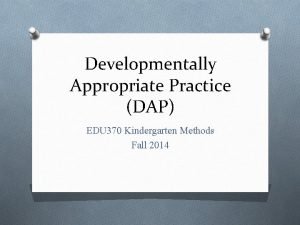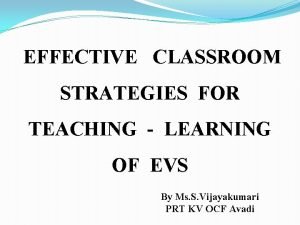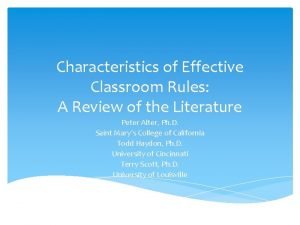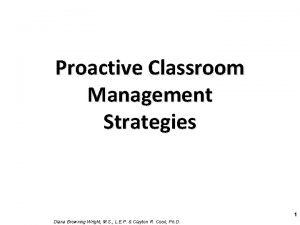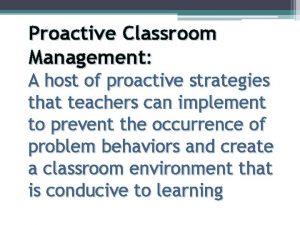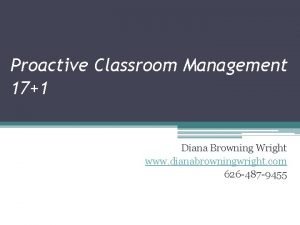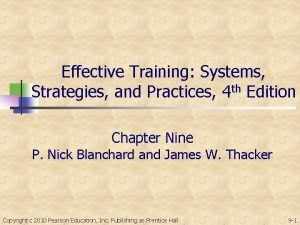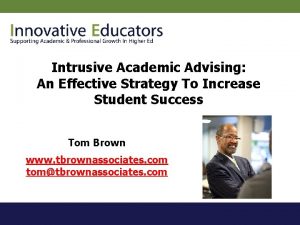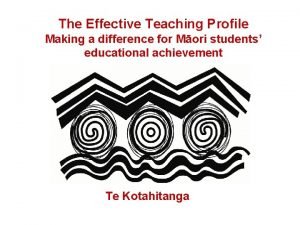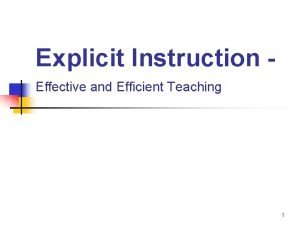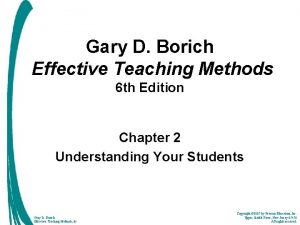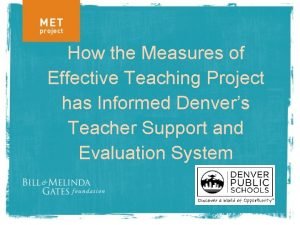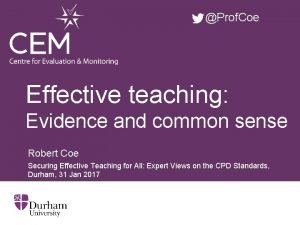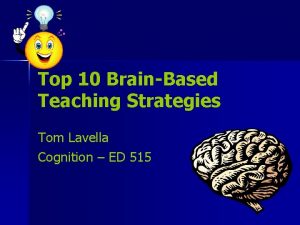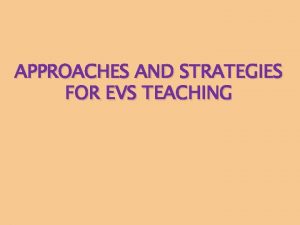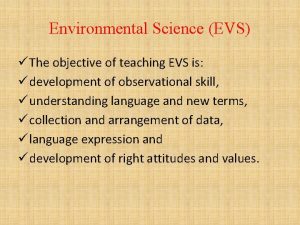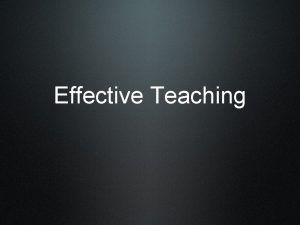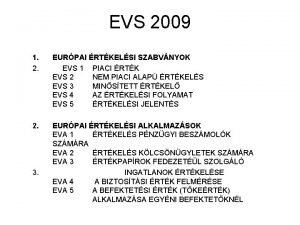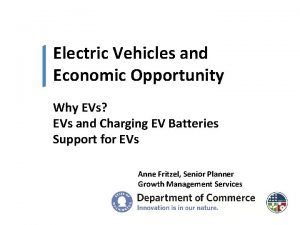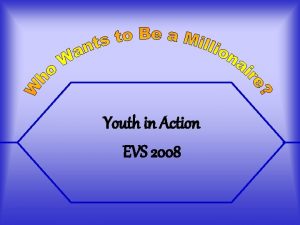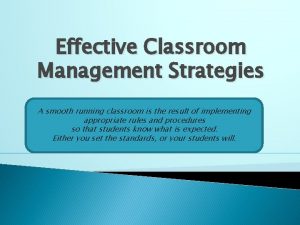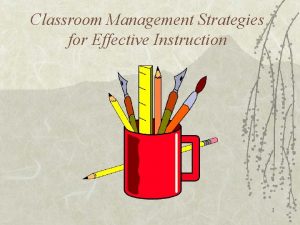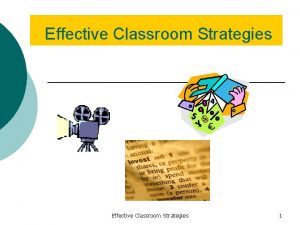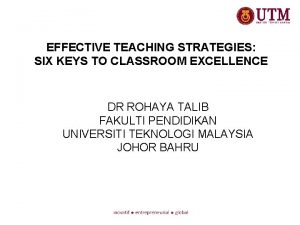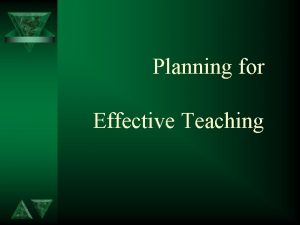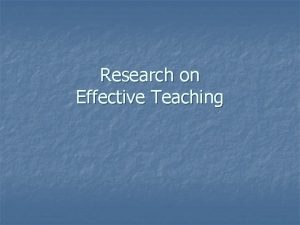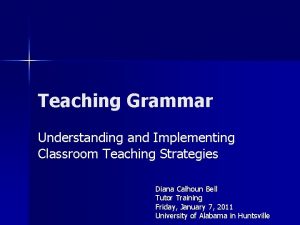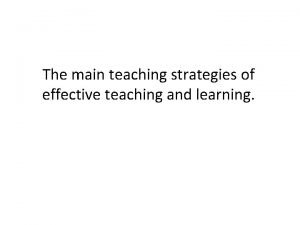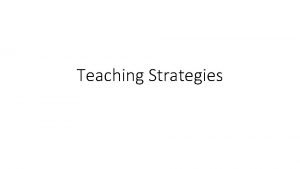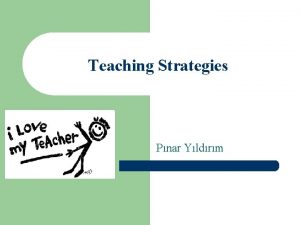EFFECTIVE CLASSROOM STRATEGIES FOR TEACHING LEARNING OF EVS




















- Slides: 20

EFFECTIVE CLASSROOM STRATEGIES FOR TEACHING - LEARNING OF EVS By Ms. S. Vijayakumari PRT KV OCF Avadi

INTRODUCTION Environmental Studies is to be taught in the primary by adopting the contructivist approach recommended by NCF 2005. The teacher has to play the role of a facilitator and translate theoretical concepts into practice. Through the learning of EVS the child is curious, as he , explores, inquires, finds out , checks out his understanding and consolidates his learning.

Integrating all subjects Thematic Curriculum Integrating action and values Integrating dimensions into Emotional, Cultural ad Social learning Meaning Making learning process blending in Knowledge Spiral Curriculum Competency Based EVS Holistic World View Integrated Curriculum

CURRICULUM; • • • It is designed based on themes related to the walks of life of the children. The themes are: Family and friends which includes the sub themes Work and Play , Relationships, Plants and animals Food Shelter Water Travel Things we Make and Do

EFFECTIVE PLANNING AND TRANSACTION The teacher has to plan in advance the transactional strategy to be adopted and activities to be organized for the teaching of any concept. Environmental studies provide ample scope to teachers to relate the experiences of children with the contents of the textbook and ensure child –centred and child- friendly classroom process through such careful planning.

OBJECTIVE 1. Develop concept map and use it for planning the teaching - learning process. 2. Understand adopt suitable transactional strategies for teaching EVS effectively.

What is concept map ? And how can it be developed ? Concept map is a diagram that show relationship between concepts. It facilitates to identify sub-themes , concepts, and sub –concepts to which we want to give more or less emphasis and helps the teachers to reconceptualize the content. It helps us to understand relationship between facts and concepts through cross – links , which leads to the development of learning situations.

Concept of Trees

Advantages of concept map 1. Concept map helps in organizing and planning learning activities to enhance learning experiences of the children. 2. It facilitates integrated and holistic learning. 3. It facilitates teachers to identify what they want to emphasis. 4. Visual presentation in the concept map facilitates better understanding and learning in children. 5. It helps in understanding relationships between facts and concepts through cross links.

CLASS ROOM TRANSACTIONAL STRATEGIES Children at the primary level are more interested in learning activities , which builds on their experiences and provide scope for using their creativity and imagination. They are curious by nature and like to explore , record , experiment , discover etc as their vocabulary is not fully developed. EVS provides enough scope for teachers to engage children in numerous activities and make the teaching -learning process child centred in true sense.

CLASS ROOM TRANSACTIONAL STRATEGIES • Classroom discussion method • Field trip or excursion • Role play • Project Based Learning • Games and Simulation

Classroom discussion method Exchange of ideas and sharing experiences is one of the effective means of learning. Discussions can be formal or informal. Informal discussions are not planned by a teacher but are incidental. Teachers often engage children in such discussions everyday without any prior planning.

Formal discussions are planned in advance and involve either the entire class or small groups , each having a pre-defined set of objectives, time limit and expectations. Whether organized in small groups or in the whole class the teacher plays a very crucial role in facilitating the discussions. It also facilitates students to examine their own values and attitudes and improves their communication skills.

Field trip or excursion Teaching and learning can be integrated and child centred when moved from the confines of the classroom to the world outside. Field visits give children educational experiences away from their regular school environment. This has to be carefully planned and integrated in the teaching learning process to optimize

Role play Learning becomes more joyful for children when they are physically, intellectually, and emotionally engaged in the learning process. Role play is one such strategy that brings real life situations into the classroom. Children need to imagine a role, a context, or both and improvise a conversation.

Project Based Learning is child – centred, holistic and interdisciplinaryin nature engaging children in real life experiences. It helps children to become more independentin making decisions, think critically and solve problems through individual or collaborative efforts.

Games and Simulation At the primary level children enjoy games, dramatics, puzzles, mimes, cartoons, films etc. These activities provide ample scope for teaching various concepts. Games and simulation can be structured to promote active learning, critical thinking, problem solving and decision making skills.

Steps required for Effective Organization of Activities. �a. Proper Planning. �b. Involving children in the learning process. �c. Each child is made an active learner. �d. For each activity ensure you follow the principles of: � What? � How? Work directions step by step, including: � With whom? Where? How long? �e. Ensure you give clear instructions before each activity. It must focus on the above a, b, c, d.

RESOURCES �The main resources which aid the curriculum transaction in EVS effectively are �Nature - Locations such as ponds, lakes, garden, tree, birds , nest, pets etc. �Human Resources - Professionals, family members, friends, experts etc. �ICT / Media - Animations, Videos, , images, audios for concretizing

THANK YOU
 10 effective dap teaching strategies
10 effective dap teaching strategies Evs classroom
Evs classroom Classroom strategies for interactive learning
Classroom strategies for interactive learning Sourima mal
Sourima mal Key elements for effective classroom management
Key elements for effective classroom management Characteristics of effective classroom rules
Characteristics of effective classroom rules Diana browning
Diana browning Proactive vs reactive classroom management
Proactive vs reactive classroom management Diana browning wright
Diana browning wright Effective training systems strategies and practices
Effective training systems strategies and practices Interpersonal communication chapter 6
Interpersonal communication chapter 6 Intrusive advising
Intrusive advising Ways to address grammar in the writing classroom
Ways to address grammar in the writing classroom Cuadro comparativo de e-learning
Cuadro comparativo de e-learning Te kotahitanga effective teaching profile
Te kotahitanga effective teaching profile Examples of explicit instruction
Examples of explicit instruction Borich effective teaching methods
Borich effective teaching methods 10 principles of effective online teaching
10 principles of effective online teaching Measures of effective teaching project
Measures of effective teaching project Effective teaching evidence and practice
Effective teaching evidence and practice Top 10 brain-based teaching strategies
Top 10 brain-based teaching strategies
